
 |
Chapter Chatter |
Todd Hubing, Associate Editor |
| Have you met Tom Van Doren? Tom's been teaching engineers and engineering students
to solve EMC problems since the early days of EMC. (I'm still not sure exactly when the
early days were.) If you've ever attended one of his courses, you know that he has a knack
for reducing complex situations to their simplest and most intuitive form. You might have
a situation where a high-speed computer network with 2,000 components and four miles of
wiring fails intermittently. Tom will examine the situation, review the data and say
something like "Can't we model the problem like this?" Then he'll draw a circuit
with an inductor, two capacitors and a resistor that completely describes the problem at
hand and makes the solution obvious. I've learned a great deal from Tom over the years. He's been both a teacher and a role model to me. He officially retired from the university so that he could spend more time teaching and doing research (yes, I'm aware of the irony). He still actively leads and contributes to EMC research projects. He also travels all over the world teaching engineers to recognize and solve EMC problems. Anyone who knows Tom will tell you he's a nice person with a sincere interest in making the world a better place. Those who know him well are aware of other characteristics he possesses. For example, he always has been and always will be both a teacher and a student of engineering. He works hard and accomplishes great things, but does not seek rewards or accolades. Also, any engineer who has ever attended one of his courses or talked to him for more than five minutes knows that you should never refer to a current carrying conductor (e.g. a plane in a printed circuit board) as "ground" when Tom is present (see sidebar: Signal Ground vs. Signal Return). Since these are characteristics that I think all EMC engineers should strive to attain, I've tried to embody them in a song. If there's one thing I've learned during my brief song-writing career, it's that people seem to appreciate my songs more when I don't sing them. So, I'll just put the words down here and you can imagine the music. If you're over 35, I recommend that you imagine that this is a folk song where the tempo of the chorus is twice as fast as the rest of the song. If you are under 35, this will probably sound better as a rap song. If so, keep the tempo constant, shout the words in a monotone voice, and insert scratchy phonograph noises. The Tom Van Doren SongAs Socrates pondered the nature of life He said... [chorus] That's a tough problem and I'll tell you how
to work it. At the Scopes Monkey trial there was no question
greater He said... [chorus] That's a tough problem and I'll tell you how
to work it. Sigmund Freud dated girls one after another. Tom said... [chorus] That's a tough problem and I'll tell you how
to work it. Einstein was working on his theory of light. Tom replied... [chorus] That's a tough problem and I'll tell you how
to work it. Intel was developing their Pentium III. Tom said... [chorus] That's a tough problem and I'll tell you how
to work it. |
Signal Ground vs. Signal ReturnMany EMC problems are caused by poor grounding strategies. Tom Van Doren feels that many of these problems could be avoided by simply changing our terminology. Safety and power engineers use the word ground to refer to a conductor at a known reference voltage that does not carry current under normal circumstances. Conductors carrying intentional currents that are connected to ground are given a different name (e.g., neutral). Unfortunately, over the years, the designers of digital printed circuit boards and systems have used the word ground to refer to any conductor serving as the zero-potential reference, even when it also carries signal or power currents.This has resulted in a great deal of confusion. Design rules and grounding strategies that make perfect sense for safety or reference grounds can have disastrous consequences when applied to conductors carrying signal or power currents. The unfortunate terminology has helped to feed and clothe generations of EMC engineers, but the costs resulting from downtime and missed opportunities have been high.Tom has led a relentless campaign against overwhelming odds to correct this situation. You'll never hear Tom use the phrase ground plane or ground wire unless he is referring to a non-current carrying conductor. Instead, he prefers the terms return plane, power return, or signal return when referring to conductors that carry power or signal currents back to their source. |
David Dennis, Chair of the Atlanta Chapter reports that they held a joint meeting with the Atlanta section on November 15, 2000 featuring Mark Montrose. Mark delivered a presentation entitled "EMC and the PCB: Fundamental Concepts and Design Techniques." The discussion focused on many different aspects of PCB design relative to signal integrity and EMC. All of his concepts and techniques were explained using practical examples and clear explanations. For information on upcoming events please visit the Atlanta Chapter website at https://www.ewh.ieee.org/soc/emcs/atl/atl-emc.htm.
The IEEE EMC Society Austria Chapter held their first meeting in Graz, the capital city of Styria. The meeting was held in October and featured a talk about "EMC Measures as a Function of the Number of Pieces" presented by Andreas Suschnig at the Technical University of Graz. After the talk, Mr. Suschnig opened up a discussion with the audience. The discussion was followed by a nice social event in the city of Graz. In November, the chapter organized a lecture on EMC with two presentations. The lecture was held at the Austrian Research Center in Seibersdorf. It started at 9:00 am and ended at 12:30 pm with a short break in between. 36 people attended the meeting. The first presentation was entitled "The European Union's EMC Directive and the CE Marking of Electronic Products." The second presentation discussed EMC compliant design of electric and electronic appliances. Kurt Lamedschwandner, Chair of the EMC AUSTRIA Chapter, gave both presentations. For information on upcoming meetings you can check the Austria Chapter's website at https://ewh.ieee.org/r8/austria/Chapters/EMC/home.html.
During October Dr. Chris Holloway, Research Scientist in the Electromagnetic Field Division at the National Institute of Standards and Technology (NIST), gave three seminars. These included: "Radio Wave Propagation Modeling for Broadband Wireless Communication," "Application of the FDTD Technique for Various EM problems," and "Comparison and Analysis of Various Types of Absorber Used in Anechoic and Semi-anechoic Chambers for Testing of Digital Devices." Dr. Holloway was in Rome as a Visiting Professor at the University of Rome "La Sapienza." He was invited by the EMC group, and in particular by Professor Sarto. Chris is also on the Graduate Faculty at the University of Colorado, Boulder, where he gives courses on EM theory, wave propagation and antenna theory, and directs research for Masters and Ph.D. students.
The Chapter meeting on September 13 was a joint meeting with the Northeast Product Safety Society (NPSS). This was the 5th year of this joint event held in September each year to start out the season. The speaker was Independent Consultant and Distinguished Lecturer Douglas C. Smith. The topic presented was: "Unusual Forms of Electrostatic Discharge." The speaker reviewed ESD characteristics and described unusual forms of ESD not covered by existing Standards. This can cause interesting, if not serious, field problems. The presentation included demonstrations of some of these effects. The speaker is the author of the book "High Frequency Measurements and Noise in Electronic Circuits," and is currently working on his second book. There were 46 members and guests in attendance.
The Speaker at the Chapter meeting held on October 4 was EMCS Distinguished Lecturer, Werner Schaefer NCE, of Cisco Systems, San Jose, California. The topic was "New Advances in Radiated EMI Measurements." The speaker discussed a new test methodology for radiated EMI measurements along with its implementation in a software package. Furthermore, tools for possible data analysis (e.g. signal discrimination) and a description of different measurement systems were also presented. There were 18 members and guests in attendance.
The featured speakers at the Chapter meeting held on November 8 were Clayton Forbes and Jason Crete of National Technical Systems, Boxborough, MA. The topic presented was "The Divergence and Convergence of ETSI ETS 300-19 Series and Telcordia GR-63 Core Environmental Requirements for Telecommunications Equipment." The speakers addressed regulatory and environmental design and testing of telecommunications equipment bound for international markets. The material presented demonstrated that with proper planning, manufacturers could reduce their test costs and time to market. This will also eliminate redundant testing. There were 32 members and guests in attendance.
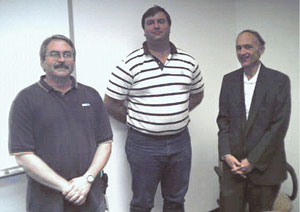 |
Tim Stevens of Dell Computer, Michael Foegelle of ETS-Lindgren and Jim Greenwood of Airep Electronics (L-R) are the newly elected Central Texas Chapter officers for 2001. |
The Central Texas Chapter of the IEEE EMC Society has elected officers for the 2001 calendar year. The new chair is Dr. Michael Foegelle with ETS-Lindgren. The new vice-chair is Tim Stevens with Dell Computer. The new secretary is Jim Greenwood with Airep Electronics. The new officers' terms expire on December 31, 2001. The URL for the chapter's website is https://www.texas-emc.fr.st/ (or https://tstevens.home.texas.net/emc/ ). The web-site may be accessed for news, links, announcements, officer contact information, and the chapter calendar of events.
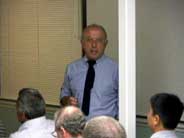 |
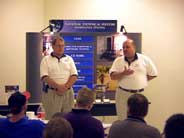 |
 |
||
Michael Mardigian taking questions from the group in attendance at the September 21st meeting. |
Jim Abel and Jim Press answering questions on Bellcore and ETSI test requirements. |
Jim Press explains the NEBS levels of testing. |
||
 |
 |
|||
Elya Joffe answers questions from the audience
relating to ElectroMagnetic
|
Bob Queen (Dallas Chapter Vice Chair), Gary Shimko (Dallas Chapter Chair), Elya Joffe and Bill Paschetag (Dallas Chapter Secretary/Treasurer) at the November meeting. |
|||
After a break for summer vacations and the 2000 IEEE Symposium on EMC, the first fall meeting of the Dallas EMC Chapter was held on September 21 at KTL in, Lewisville, Texas. Our speaker was Distinguished Lecturer Michel Mardiguian, who spoke on "Radiated EMI Compliance with Digital Clocks Above 100 MHz." There were 25 in attendance (17 IEEE members). KTL provided pizza and soft drinks prior to the meeting. The second fall meeting was held on October 17 at NTS in Plano, Texas. Our speaker was Jim Press, NTS Chief Engineer, who spoke on the differences in requirements between Bellcore GR-1089-CORE and ETSI 300-386. There were 42 in attendance (16 IEEE members). After the meeting, Jim Press and Jim Abel conducted a tour of the newly installed Bellcore test facility at NTS Plano. NTS provided barbeque and soft drinks prior to the meeting. The final fall meeting was held on November 13 and was also at NTS in, Plano, Texas. Our speaker was EMCS Distinguished Lecturer Elya Joffe, who spoke on "Electrophobia: Why are People Really Scared of Electromagnetic Fields?" He discussed several examples of transmitter installations and several studies conducted to determine RF hazards in Israel. There were 46 in attendance (29 IEEE members). Joe Stanfield of SEI, Richardson, Texas, provided pizza and soft drinks prior to the meeting. KTL came to the rescue by providing a pc-compatible projector to show Elya's PowerPoint presentation. Our thanks go to Dale Reynolds (of KTL in Lewisville) for his assistance with the projector.
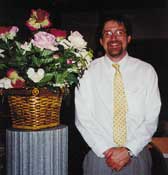 |
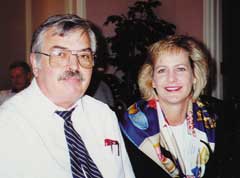 |
|
Jim Marley of Underwriters Laboratories at Research Triangle Park, North Carolina, chairs the local EMC chapter and organizes EMC events. he is shown taking a break during the one-day tutorial and exhibition he chaired on October 23. |
Clayton Paul and Janet O'Neil participated in the Eastern North Carolina Chapter event on October 23. Dr. Paul provided the tutorial "The Fundamentals of EMC" while Ms. O'Neil organized the vendor activity of table-top displays. |
 |
Jeff Marquart (L) of Home Director was the lucky winner of the raffle drawing for a Fischer Custom Communications (FCC) probe. The raffle was held during the reception following the Clayton Paul tutorial. Allen Fischer (R) of FCC was pleased to donate the probe to the Eastern North Carolina Chapter. |
Despite being a relatively new chapter, the Eastern North Carolina EMC Chapter decided to hold a one-day regional EMC event with Clayton R. Paul as the headline speaker. (Of course, how can you go wrong with a big name speaker like that?) It was their first big event and it was a huge success. Jim Marley of Underwriters Laboratories, Inc. and his staff took care of registration and the general administrative running of the event. (Thanks Melissa!) Jim is chairman of the Eastern North Carolina EMC Chapter. Some 80 EMC engineers attended the one-day tutorial presented by Dr. Paul titled "The Fundamentals of EMC." The majority of the engineers present were new to EMC so the topic was perfect. Engineers came largely from the greater Research Triangle Park area, but also from as far away as Atlanta. There were several vendors present who displayed the latest in EMC products and services from the table-top display area. Thanks go to Dr. Paul for donating his time to make this presentation and to the participating vendors for contributing to the event's success.
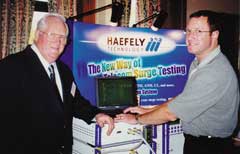 |
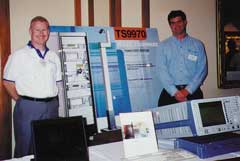 |
|
Participating vendors at the Clayton Paul October 23 event included Bill Watts of EMC Technologists and Tom Revesz of Haefely Test (L-R). |
The Rohde & Schwarz dynamic duo of Sean Emerson and Vic Hudson (L-R) presented the latest in EMC test instrumentation during the Eastern North Carolina Chapter event on October 23. |
|
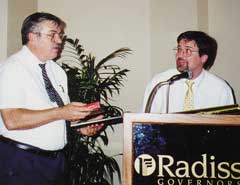 |
 |
|
The Eastern North Carolina Chapter event on October 23 was a huge success thanks to the efforts of the illustrious speaker, Clayton Paul. Jim Marley (R) is shown expressing thanks for a job well done at the conclusion of the tutorial. |
Lunchtime at the Clayton Paul event provided some good networking time for the EMC engineers present, including (L-R) Claude Cesard of Schaffner, Ed Vitek of Ericsson and William Scheer of Quantum Change. |
In November, the Germany chapter elected new officers to three-year terms. The chair is Prof. Dr.-Ing. Heyno Garbe of the University of Hannover. The vice-chair is Dipl.-Ing. Diethard E. C. Mšhr of Siemens AG. The treasurer is Dr.-Ing. Frank Sabath. The Technical Activities Chair is Dr. Frank Gronwald of the University of Magdeburg.
 |
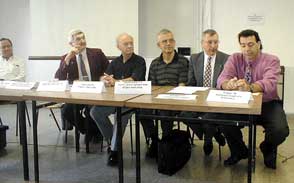 |
|
Israel Chapter photo of the organizers, including (L to R): Prof. Jacob Gavan, Moshe Netzer, Lt. Col. Amnon Davdevany, elya Joffe, Dr. Yossi Pecker, Dr. Alex Vilensky, Oren Hartal. |
Israel Chapter opening panel, including (L to R): Moshe Netzer, Elya Joffe, Oren Hartal, Dr. Alex Vilensky, Dr. Yossi Pecker, Jacob Hai (AEAI). |
On November 23, the Israel IEEE EMC Chapter held the last Chapter meeting of the year 2000. The meeting consisted of a full day workshop, hosted and co-sponsored by the AEAI, the Association of Engineers and Architects in Israel. The meeting was held in the beautiful coastal city of Haifa. Over 120 participants took part in this meeting, including representatives from the high tech industry, military, standards organizations and development institutes. The Workshop was dedicated to a professional discussion of biological effects of EMF, and was intended to present facts and up-to-date information on this topic, free from public hysteria and bias. Chapter members and guest experts presented the lectures delivered in the workshop. They dealt with "hot" topics in this field, including: "Main Characteristics of Cellular Technology and Environmental Considerations from the Service Providers' Perspective," by Mr. Zvi Sh'hori, Cellcom; "Non Thermal Effects of Exposure to Non-Ionizing Radiation," by Dr. Joshua Weissman, Elbit, Computers, Ltd.; "Possible Effects of Cellular Radiation on Cancer," by Dr. Sigal Sadetzki, Tel-Hashomer Hospital; "Development of Techniques for Increase of Radiation Efficiency, Quality of Communications and Reduction of SAR of Hand-Held Wireless Telephone," by Prof. Jacob Gavan, Holon Academic Technological Center; "Development of Statistical Distributions of Radiated Power Density, for Human Exposure from Base Stations and Hand Held Phones," by Dr. Yuri Zlotnikov and Prof. Jacob Gavan, Holon Academic Technological Center; "Safety of Usage of Personal Hand Free Speakers for Cellular Phones – What Mislead the Britons?", by Dr. Menahem Margaliot, Soreq Nuclear Research Center; "Level of Exposure to Cellular Phone Radiation in the Presence of a Corner reflector," by Mr. Oren Hartal, RAFAEL/ADA; and "Impressions from the Millennium Workshop in Crete Regarding Biological Effects of Electromagnetic Radiation," by Mr. Moshe Netzer, RAFAEL/ADA.
At the end of the presentations, an expert panel was held, with all speakers, and Mr. Emil Koifman, Chair of the Society of Electrical and Electronics Engineers in the National AEAI. In addition to the above topics, this meeting was also dedicated to the presentation of awards on behalf of the IEEE EMC Society (presented at the 2000 IEEE International Symposium on EMC in Washington, DC). Awards were given to the following, in the presence of Chapter members and all other attendees: Moshe Netzer, Certificate of Appreciation, for continuing and outstanding support of the Israel Chapter and the development of its technical activities and for promoting the cooperation between the Israel EMC Chapter and related (non EMC) organizations, Moshe Henig, Certificate of Appreciation, for continuing and outstanding support of the Israel Chapter, with particular emphasis on increasing the support and cooperation between high-tech industries and the Israel IEEE EMC Chapter and Moshe Netzer, Certificate of Achievement, for over two decades of significant professional achievements and leadership, in Israel and internationally, in the study and development of models for Electromagnetic Interactions with Ordnance (HERO) and Electrostatic Discharge (ESD) hazards. In addition, the Israel EMC Chapter was awarded the "Most Improved Chapter of the Year" award for the year 1999-2000.
It is noteworthy that another award, Certificate of Appreciation, was presented to Mr. Albert Kalo, for his leadership and pioneering in the development of EMC Standardization in Israel, as Chairman of the Israel Technical Committee for EMC, which led to the national recognition of the need for Israeli EMC Standards. This award was presented to Mr. Kalo in a special, ceremonial meeting of the Technical Committee for EMC Standardization, in the presence of the CEO of Israel's Institution of Standards, Mrs. Ziva Patir. The entire event was a great success as noted by all attendees. An extended article on the event was also published in the Newsletter "Mehandesim" ("Engineers") of the AEAI.
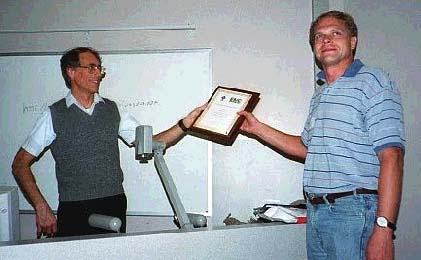 |
Melbourne Chapter Chair Bruce Crain (right) presents IEEE EMCS Distinguished Lecturer Doug Smith a Certificate of Appreciation. |
Ed Kirchner, secretary of the Melbourne chapter, reports that their November meeting was held on the campus of the Florida Institute of Technology. 28 engineers were treated to a lecture by Mr. Doug Smith, an IEEE EMC Society Distinguished Lecturer. Doug spoke on the subject of "Unusual Forms of ESD." His entertaining lecture, which included both dramatic demonstrations and amusing anecdotes, taught the audience that disruptive ESD discharges might be generated from such unexpected sources as loose change jingling in a pocket, and sitting down in a common office chair. As is often the case for EMI/EMC problems, Doug described how successful identification and elimination of these unique ESD upsets takes a good combination of practical and theoretical engineering skills, as well as an inquisitive and imaginative nature. The audience left the meeting with a great deal of new knowledge, including how to impress your friends with an office chair and an AM radio. A word of thanks goes out to Dave Baker of Agilent Technologies and Joe Barbee of Rubicom Systems for enabling the demos by loaning us test equipment! Prior to Doug's lecture, the crowd enjoyed pizza and cold drinks in the Florida Tech lecture hall lobby, while talking informally about local issues important to EMC engineers. The number of people attending this meeting was the highest total so far for the Melbourne Chapter, which completed its first full year in 2000. We look forward to further growth in 2001.
Ali Elmi reports that the Oregon and SW Washington chapter started the season in September with a four-hour workshop presented by Dr. Tom Van Doren from the University of Missouri-Rolla. The workshop was held at Intel in Hillsboro. The topic of his presentation was "How to Diagnose Electrical Noise Problems." There are only four mechanisms for transferring electrical energy. Each noise coupling mechanism and the conditions necessary for determining its existence was discussed. Then equivalent circuits were presented to model these mechanisms. At the end of the presentation, teams were created for a competition and the participants were given an opportunity to diagnose several practical examples.
In October, Mr. Kevin Slattery of Intel Corporation presented "Near Field Surface Scanning of VLSI Devices." The presentation described three methods that a designer needs for identifying and characterizing emissions sources, particularly those associated with VLSI devices such as microprocessors, ASICs and other large scale devices that use high speed clocks. The topic was very interesting and even included a slide of the measurement system used, the BMG1 (Big Metal Gizmo).
In November, Mr. Jim Muccioli of Jastech EMC Consulting presented "X2Y Filter Technology as Single Component Solution for Noise Suppression." The presentation was about the new capacitive technology introduced by X2Y Attenuators which is an architecture that can be used to manufacture a variety of devices, including capacitors, decouplers, transient voltage suppressors, and filters, thus overcoming the limitations of currently available signal-integrity solutions by reducing the number of parts while enhancing performance. In December, the chapter held its annual Holiday Social at the Governor Hotel in downtown Portland. This was a chance for Chapter members and their significant others to mingle in a non-technical environment. A good time was had by all that attended.
 |
Doug Smith demonstrates the problems associated with off-the-shelf scope probes on a 50MHz clock signal. |
Harry Gaul reports that the Phoenix chapter held a half-day EMC workshop on October 19th, 2000. The featured speaker, Doug Smith was delayed by an hour due to airline problems, so Daryl Gerke filled in at the last minute with an encore presentation of his light-hearted talk on "Design For Failure." In this talk we learned the worst ways to design for EMC such as maximizing emissions through the use of pigtails and other antenna-like structures. The benefits of designing for failure include gaining visibility from the company's vice-presidents and ensuring a steady workload for the EMC department. Many thanks go to Daryl for warming up the audience prior to Doug's arrival.
The featured speaker, Doug Smith of D.C. Smith Consultants presented an enlightening talk on "Overview of High-Frequency Measurements for Design and Troubleshooting."
In this talk, Doug explained how the typical 10x, 10 Megohm off-the-shelf oscilloscope probes are advertised as high-impedance but in reality have an impedance that becomes quite low for frequencies above a few tens of MHz. Indeed, for signal frequencies above 30 MHz, a better probe selection would be a 500-ohm low impedance probe. That probe is easily made by simply inserting a 450-ohm resistor in the end of a coaxial cable.
Another major problem with scope probes is the influence of the ground lead. Balanced probes provide a good way to reduce the ringing effects associated with ground leads. Doug shared with us a design for a balanced coaxial probe that can be built rather inexpensively by using a Mini-Circuits RF combiner. The frequency range of the probe is from 1MHz to 500MHz.
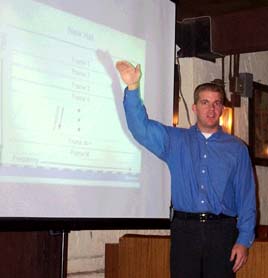 |
Matt Hommond explains the differences between swept-heterodyne and real-time spectrum analyzers. |
One final thought that Doug left us with was that when performing EMC tests of Category 5 Ethernet products, one should always use new cables. Otherwise, old cables may have kinks that will disturb the balance of the cable with a consequent increase in common mode emissions.
On December 7, Matt Hammond of Tektronix presented a talk entitled "How to Choose the Correct Spectrum Analyzer for Your Application." This talk was a discussion of the differences between swept-heterodyne and real-time spectrum analyzers. The conventional swept-heterodyne spectrum analyzers are very useful when dynamic range and phase noise are important. But they can miss transient signals such as frequency hopping carriers. The real-time spectrum analyzers can be very useful for transient signals because they do not have time gaps in their acquisition.
Essentially, the real-time analyzers have an analog RF front end with a 30MHz wide IF. The IF output signal is digitized in the time domain and converted using FFT techniques into the frequency domain. The resulting measurement then is displayed in three dimensions including frequency, amplitude, and time.
Matt concluded his talk with a demonstration of the two types of analyzers with a frequency-hopping signal as the source. Check out our web site at https://www.ewh.ieee.org/r6/phoenix/phoenixemc/ for the latest schedule on upcoming talks.
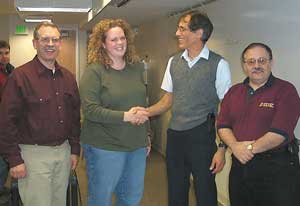 |
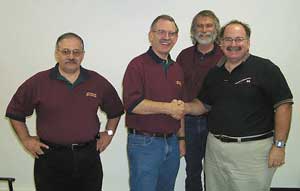 |
|
Lyle Luttrell, RMC Chapter chair, Jennifer Flint, CSU Chapter Chair, Doug Smith, speaker, and Chas Grasso, RMC Vice Chair wrap-up a successful joint meeting between the Rocky Mountain Chapter and SCU Student Chapter. |
RMC Chapter officers Chas Grasso, Lyle Luttrell, and Bob Reinert welcome Dr. Eric Bagatin at his presentation on Differential Impedance Finally Made Easy. |
At the October meeting, 28 members and guests enjoyed a highly interactive and informative technical program on "Differential Impedance Finally Made Easy" presented by Dr. Eric Bogatin. An increasing number of designs are leveraging the performance features of differential pairs. Yet their behavior and design principles are confusing to most engineers. In this presentation, Dr. Bogatin first reviewed the basic notion of characteristic impedance of one line and then extended this to two lines and introduced the principle of differential impedance. He then looked at how the geometry and material properties affect this important parameter. Finally, he looked at some of the special properties of differential pairs, such as crossing a split in the return path and transitioning from a differential pair on a circuit board to a twisted pair. It doesn't get any simpler than this. Dr. Bogatin divided the afternoon into two, one-hour lectures with a 15-minute break in the middle and time at the end for questions. The presentation materials for this and previous meetings are available for download at the chapter website, https://www.ieee.org/rmcemc
The November 30 meeting was another Rocky Mountain Chapter first: a joint meeting with the Colorado State University IEEE Student Chapter, thanks to CSU Chapter Chair, Jennifer Flint, and advisor Dr. Carmen Menoni for working with Chas Grasso and Doug Smith to arrange the special meeting at CSU. 32 RMC and CSU chapter members attended to hear Doug Smith present "EFT Testing Per IEC 61000-4-4 (and some unusual uses for an EFT generator!)." Doug described the background of EFT testing (IEC 61000-4-4) along with common pitfalls. Doug also shared some tips on the testing process, including a common mistake that some test labs make that can nearly double the stress on the EUT. If you have an EFT Burst Generator, what do you do with it when it is not being used (probably most of the time unless you work for a test lab)? Doug covered some test/debug techniques using an EFT generator that have nothing to do with EFT, such as solving ESD problems and measuring noise margins at the PWB and circuit trace level. Doug kept everyone's attention with his anecdotes and war stories about EMC phenomena past, present and future.
In December, the Rocky Mountain Chapter sponsored a one day seminar on "High Frequency Measurements and Noise in Electronic Circuits" by Douglas C. Smith. Ten people attended this seminar where Doug described in depth how to measure signal and noise in high-speed digital and analog circuits as well as switching power supplies. These measurements were then used to characterize high-speed effects in electronic circuits including design verification and troubleshooting. Sources of measurement error were discussed. This seminar also explored the connection between signal integrity and EMC. The measurement techniques were related to design issues to improve equipment EMC and signal integrity performance and improve the overall reliability of electronic systems.
 |
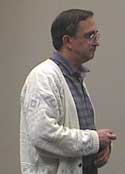 |
|
Seattle EMC Chapter Members Len Carlson and Gordon Mills (L-R) enjoy the October chapter meeting. |
Speaker Kevin Slattery of Intel pauses to think before answering an in-depth question following his presentation to the October Seattle EMC Chapter meeting. |
In October, the Seattle Chapter participated in "Milwaukee Night" at IEEE Northcon/2000 in Bellevue. The meeting was held at the Meydenbauer Center. "Milwaukee Night" is a unique event where several IEEE Society chapters hold their meetings concurrently. Participating chapters included those representing the EMC, Computer, Circuits and Systems, Power Engineering and Power Electronics Societies. Each chapter had their respective speakers present their material twice in one night with a break in between. That meant attendees could sit in on one chapter's presentation, take a break, and then sit in on another chapter's presentation. You could conveniently attend two Society chapter meetings in one night! The Seattle EMC Chapter's program featured "Techniques for the EMI Evaluation of VLSI Devices" by Kevin Slattery of Intel Corporation in Hillsboro, Oregon. Kevin explained that at the heart of almost every EMI/EMC problem is what to do about the source of emissions. These emissions may be causing problems in the surrounding environment through direct radiated interference or they may show themselves by creating functional problems within the module circuitry itself. In all cases, the designer needs a method for identifying and then characterizing these emissions. Kevin's presentation described three methods for accomplishing this. It was concerned primarily with emissions generated by VLSI devices such as microprocessors, ASICs and other large scale devices that use high-speed clocks. Two of the methods described were essentially similar, but differed in the frequency range that they address. The third method was complementary to the first two in that, once having characterized the spectrum of concern, the designer can use this method to investigate the geometry of the emissions at the device package and die level. Kevin Slattery is presently employed by Intel in the Desktop Architecture Lab in Oregon, where he works on EMI at the silicon level. Previously, he worked at Daimler Chrysler in Hunstville, Alabama, where he performed EMC testing and analysis for Chrysler automotive electronics. He moved to the great Pacific Northwest two years ago. Kevin says he loves it here, he enjoys the rain, and he doesn't miss the heat of Alabama. He also likes the fine Pinot Noirs from the Oregon wineries.
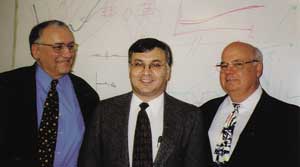 |
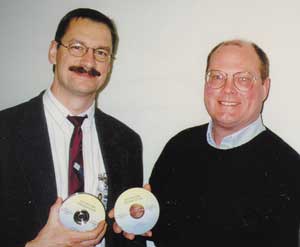 |
Jim Muccioli of Jastech EMC Consulting was the speaker for the November Chapter meeting. He explained the new capacitive technology introduced by X2Y Attenuators. Tony Anthony (L) invented the technology and was there to lend support to Jim's presentation. He was joined by Don Harris (R), also of X2Y Attenuators. |
Seattle Chapter Vice-Chairman Pat Andre of CKC Labs and Bill Hall of Wiliam P. Hall Contract Services (L-R) picked up a CD of Jim Muccioli's presentation which also included related technical papers and articles on the X2Y technology. |
In November, the technical program featured "New X2Y Filter Technology Emerges as Single Component Solution for Noise Suppression" by James P. Muccioli. Jim showed how a new capacitive technology introduced by X2Y Attenuators LLC, Erie, Pa., can overcome the limitations of currently available signal-integrity solutions by reducing parts count while enhancing performance. He also showed how it opens the door to multi-source solutions and explained that X2Y technology is not a capacitor per se, but rather an architecture that can be used to manufacture a variety of devices, including capacitors, decouplers, transient voltage suppressors, and filters. Jim Muccioli is associated with Jastech EMC Consulting, LLC and X2Y Attenuators, LLC. His talk was quite entertaining and informative. The chapter members asked many penetrating questions throughout the presentation which clearly indicated their interest in the topic. Jim can be reached by e-mail at jpmuccioli@telocity.com if your interest is piqued. This meeting was held at CKC Labs in Redmond who treated the Chapter to pizza and soft drinks before the presentation. Thanks Pat!
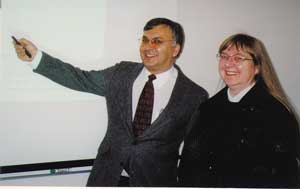 |
Dr. Lynne Green of Innoveda asked for clarification of one point in Jim Muccioli's presentation. Mr. Muccioli was happy to oblige! |
Visit the IEEE Seattle Section website at www.ieee-seattle.org/ for more information on the Seattle EMC Chapter's current and future activities. EMC